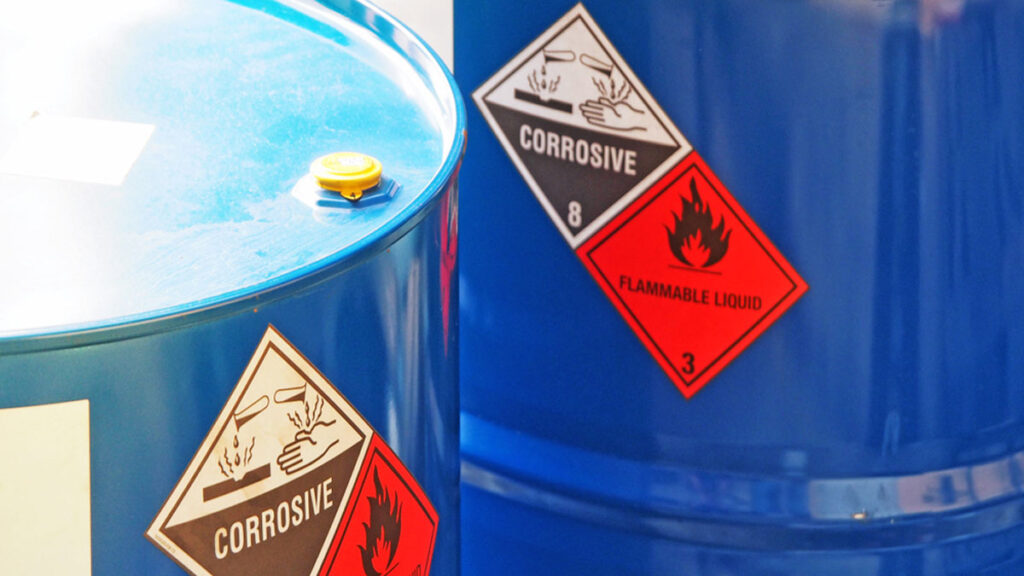Introduction
External storage is a feature in a wide range of businesses / properties, and this can involve a range of assets, including: raw materials, partly manufactured products or components, crated finished products awaiting despatch, flammable liquids and gases.
However, the most commonly encountered combustible items stored externally are:
- Pallets (timber or plastic) and waste bins, skips and compactors.

What is the Risk?
Externally stored goods are at risk of ignition, either through accidental or deliberate acts, including:
- Malicious ignition by vandals or arsonists.
- Ignition by carelessly discarded smoking materials, heat and sparks, or from fireworks and Chinese lanterns landing on the site.
- Spontaneous combustion of oil contaminated waste, organic matter and other susceptible materials.
- The risk of fire spread from adjacent buildings, plant and vehicles.
Whilst the loss of a few pallets or contents of a waste skip is unlikely to be too significant, should the fire spread to buildings or goods, the loss could be substantially greater.
In some instances, even if the fire does not spread, smoke may cause significant damage with subsequent interruption to the business, particularly where stocks are susceptible to contamination, such as foodstuffs, clothing, sensitive equipment / components etc.
What Risk Control Measures should we be looking for?
a) Prevention of Ignition:
- Prohibition of smoking or siting of external smoking shelters in suitable positions away from property and with appropriate smoking waste receptacles provided.
- Prohibition of burning of waste.
- Adequate control of contractors – Use of Hot Work permits etc.
- Secure perimeter fencing and locked gates can help prevent unauthorised access to the storage areas.
- Locating storage away from the perimeter of the site, reducing the risk of lighted materials being introduced maliciously from outside the site.
- The presence of monitored CCTV or site security guards can help to identify site intrusion and deal with unauthorised access before a fire is set.
- Securing lids on skips and waste containers can help prevent ignited materials being introduced into combustible waste.
- Controls for oily/greasy or impregnated waste, rags or wipes, such as in secured metal lidded bins.
- Adequate storage conditions for gases, e.g. appropriate secured cages / enclosures, away from potential ignition sources, with good ventilation and shaded from direct sunlight.
b) Prevention of Spread:
- The presence of monitored CCTV or on-site guards can help in the early discovery and reporting of a fire, so it is more likely to be brought under control before spreading to buildings.
- Securing lids on skips and bins can help prevent a fire developing by restricting oxygen (suffocation) and containment.
- Keeping external storage to a minimum will limit fuel for the fire and consequently reduce its potential to spread.
- Ensuring that external storage locations for combustible materials are at a sufficient distance from buildings, and other property, will limit the likelihood of fire spread to such buildings (this includes the risk of spread to third party premises).
- Good housekeeping practices in external storage areas, including maintaining clear spaces between stored goods, and regular removal of waste packaging and other loose combustible materials, will limit the likelihood of fire spread between goods stored in the open.
How Far Should Combustible Materials Be Kept from Buildings?
The simple response to this is as far as reasonably practical, and as a general rule it would be expected that such materials are kept at least 5 metres from the building. However individual risk factors must be considered, including but not limited to:
- Where there is “significant” external storage of combustibles (over 250m3), it would be expected that this would be at least 10 metres clear of buildings or 3x the storage height of materials (to take into account the effect of collapse during fire conditions).
- Where the insured building (or any nearby building) is of “combustible or highly combustible construction” increased storage distances will be required. Also, where the trade (or nearby trades) is a high fire risk in nature.
- The Loss Prevention Certification Board (LPCB) sprinkler rules specify minimum clearances for some protected premises.
- In exceptional cases, it may be possible to store combustibles closer than 5 metres, such as where the building is of fire resisting construction with no openings (doors/windows). These should be considered on a case-by-case basis and involve appropriate consultation with a Risk Control Surveyor.